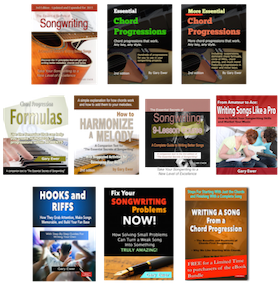You can strengthen chord progressions by defining a goal and then working backwards.
___________
Buy “The Essential Secrets of Songwriting” eBook Bundle, and get back to songwriting excellence.
___________
 Yesterday, we looked at how to work backwards with lyrics. We saw that getting the chorus lyrics working first made it easier to work out verse ideas. Now let’s look at chord progressions.
Yesterday, we looked at how to work backwards with lyrics. We saw that getting the chorus lyrics working first made it easier to work out verse ideas. Now let’s look at chord progressions.
A chord progression, at least of the type that you’ll find in most songs of pop genres, focus in on one particular chord as a tonic — a kind of anchor. So it makes sense to start with that all-important chord, and then find a chord that moves well toward it. Now you’ve got two working chords; time to look for the chord that will move well to that one, and so on.
A particularly good way to do this is as follows… Let’s assume your song is in C major, meaning that the 7 chords you’ll use are probably going to come mostly from this list: C Dm Em F G Am Bdim.
- On a piece of paper, write C.
- Now write the chord that’s 4 notes lower: G. You’ve now got a progression: G C.
- Now write the chords that’s 4 notes lower than G: Dm. You’ve now got: Dm G C.
- Keep going in this way until you’ve got a progression that’s about as long as you think you need. If you do the preceding steps two more times, you’ll have this: Em Am Dm G C.
- Now stick the chord C at the beginning of your list. That gives you this: C Em Am Dm G C.
You’ve worked out most of the progression in reverse. Now play it forwards, and it gives you something you can either use as is, or modify for your own use.
As you can see, the progression you’ve come up with is the standard circle of fifths, and it forms the backbone of many songs in pop music. Don’t worry about the predictable nature of this progression. As I say, it serves as a good starting point, a point from which you can branch out to design more creative progressions.
______________
Written by Gary Ewer. Follow on Twitter.
“The Essential Secrets of Songwriting” 10-eBook Bundle – Get it, along with a special deal.











Pingback: A Harmony Part for “Lullaby of Birdland” (+free sheet music) | Sound the Trumpet: How to Blow Your Own Horn